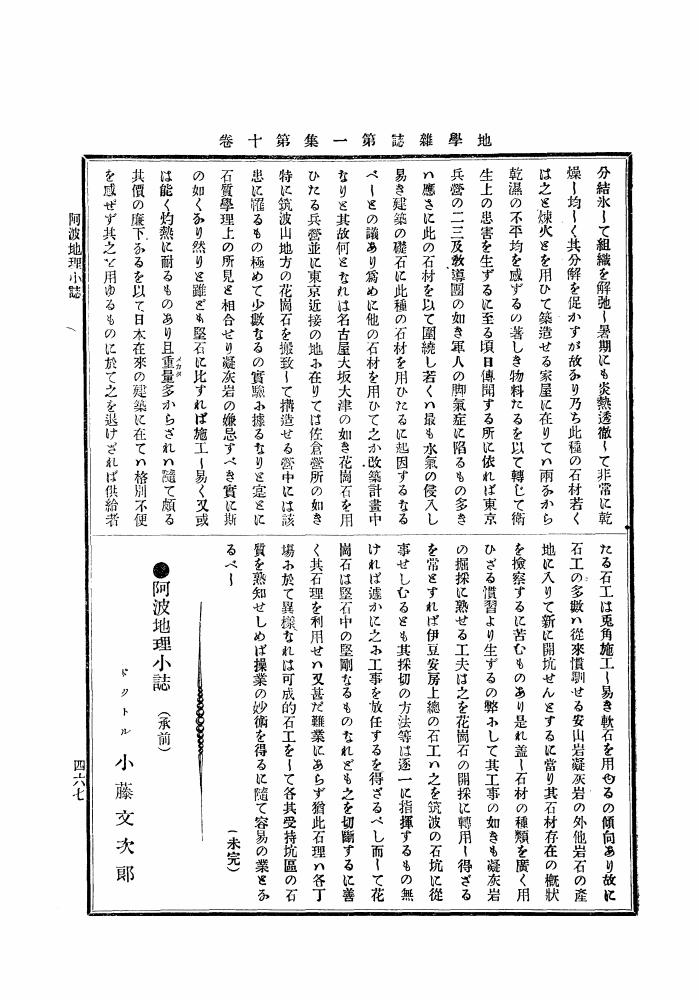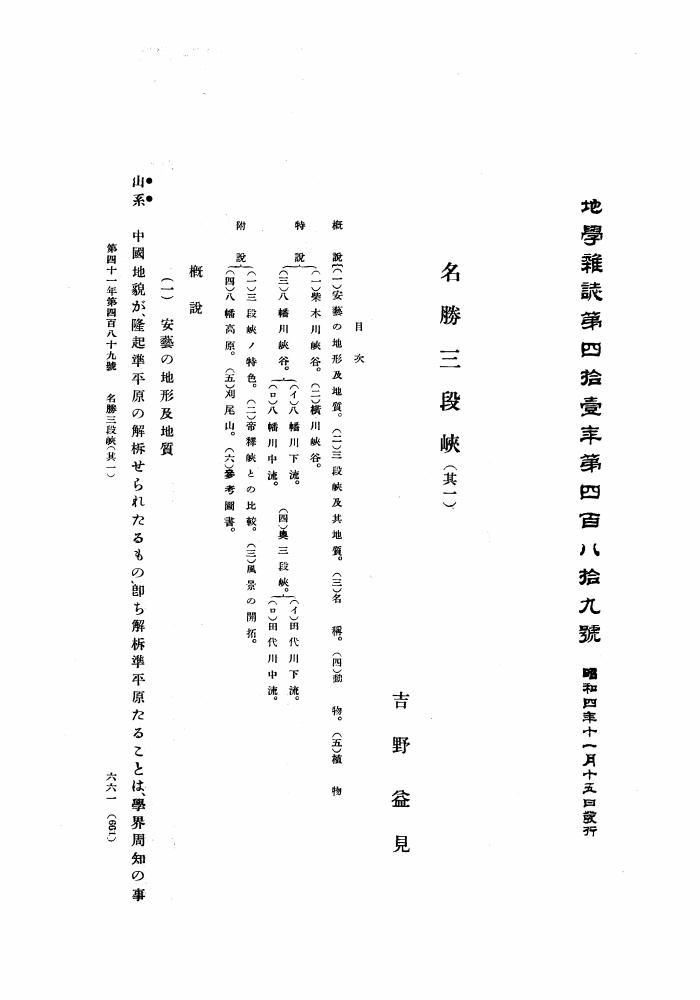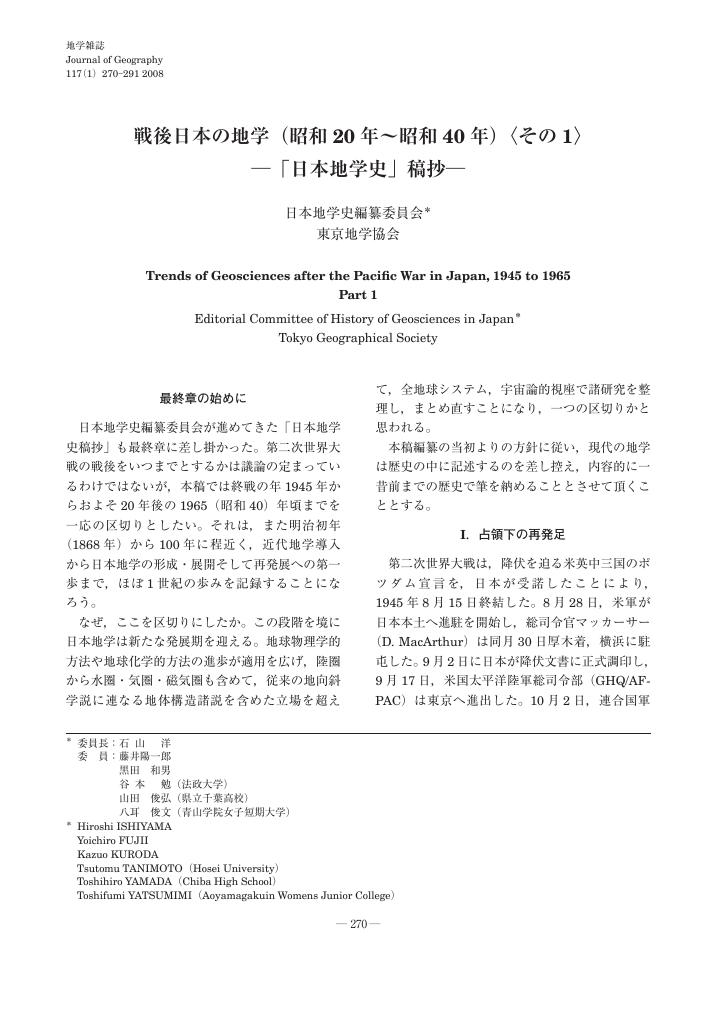1 0 0 0 OA 阿波地理小誌
- 著者
- 小藤 文次郎
- 出版者
- 公益社団法人 東京地学協会
- 雑誌
- 地学雑誌 (ISSN:0022135X)
- 巻号頁・発行日
- vol.1, no.8, pp.347-354, 1889-08-25 (Released:2010-10-13)
1 0 0 0 OA 阿波地理小誌
- 著者
- 小藤 文次郎
- 出版者
- 公益社団法人 東京地学協会
- 雑誌
- 地学雑誌 (ISSN:0022135X)
- 巻号頁・発行日
- vol.1, no.9, pp.415-419, 1889-09-25 (Released:2010-10-13)
1 0 0 0 OA 阿波地理小誌
- 著者
- 小藤 文次郎
- 出版者
- 公益社団法人 東京地学協会
- 雑誌
- 地学雑誌 (ISSN:0022135X)
- 巻号頁・発行日
- vol.1, no.6, pp.241-248, 1889-06-25 (Released:2010-10-13)
1 0 0 0 OA 阿波地理小誌
- 著者
- 小藤 文次郎
- 出版者
- 公益社団法人 東京地学協会
- 雑誌
- 地学雑誌 (ISSN:0022135X)
- 巻号頁・発行日
- vol.1, no.7, pp.291-294, 1889-07-25 (Released:2010-10-13)
1 0 0 0 OA 阿波地理小誌
- 著者
- 小藤 文次郎
- 出版者
- 公益社団法人 東京地学協会
- 雑誌
- 地学雑誌 (ISSN:0022135X)
- 巻号頁・発行日
- vol.1, no.10, pp.467-471, 1889-10-25 (Released:2010-10-13)
1 0 0 0 OA 中部山岳地域における気象観測網の展開
- 著者
- 鈴木 啓助 佐々木 明彦
- 出版者
- 公益社団法人 東京地学協会
- 雑誌
- 地学雑誌 (ISSN:0022135X)
- 巻号頁・発行日
- vol.128, no.1, pp.9-19, 2019-02-25 (Released:2019-04-03)
- 参考文献数
- 10
- 被引用文献数
- 7 8
Mountainous areas are quite sensitive to global-scale environmental changes, such as warming. Therefore, the effect of global warming on these meteorological elements is a critical issue. However, Mt. Fuji Weather Station, which was once a symbol of meteorological observation in mountainous areas, has remained unmanned since August 2004. Of the other observation sites of the Japan Meteorological Agency, Nobeyama, at 1350 m.a.s.l. elevation, is the highest. When evaluating the effects of a global-scale warming event on regional-scale environmental change in the Japanese Alps at a high elevation of 1350 m.a.s.l., it must be noted that the lack of meteorological observation data at high elevations impedes any evaluations of the effects of warming on the ecological system and water resources in mountainous ranges. A network of 14 meteorological observatories has been developed by Shinshu University in the Japanese Alps, which have already started recording observations. The highest observation site is Mt. Yari, at 3125 m.a.s.l.. Observation data from these sites are sent to a computer at the laboratory via a data communication mobile telephone network or a phone line throughout the year. These meteorological observation data are available on the laboratory website in quasi-real time. The interannual variability of annual mean temperature and snow depth in the Japanese Alps region are discussed.
1 0 0 0 OA 名勝三段峡 (其三)
- 著者
- 吉野 益見
- 出版者
- 公益社団法人 東京地学協会
- 雑誌
- 地学雑誌 (ISSN:0022135X)
- 巻号頁・発行日
- vol.42, no.1, pp.40-52, 1930-01-15 (Released:2010-10-13)
- 参考文献数
- 20
1 0 0 0 OA 名勝三段峡 (其二)
- 著者
- 吉野 盆見
- 出版者
- 公益社団法人 東京地学協会
- 雑誌
- 地学雑誌 (ISSN:0022135X)
- 巻号頁・発行日
- vol.41, no.12, pp.777-788, 1929-12-15 (Released:2010-10-13)
1 0 0 0 OA 名勝三段峡 (其一)
- 著者
- 吉野 盆見
- 出版者
- 公益社団法人 東京地学協会
- 雑誌
- 地学雑誌 (ISSN:0022135X)
- 巻号頁・発行日
- vol.41, no.11, pp.661-676, 1929-11-15 (Released:2010-10-13)
1 0 0 0 南関東における第四紀中期のテフラの対比とそれに基づく編年
- 著者
- 町田 洋 新井 房夫 村田 明美 袴田 和夫
- 出版者
- 公益社団法人 東京地学協会
- 雑誌
- 地學雜誌 (ISSN:0022135X)
- 巻号頁・発行日
- vol.83, no.5, pp.302-338, 1974
- 被引用文献数
- 25 17
This paper presents the basic data for tephrochronology of the Middle Pleistocene events of South Kanto, Central Japan. The tephra preceding to the last interglacial age (the Tama tephra) is found in highly dissected terraces (Fig. 1) much thicker than the younger tephra formations (Fig. 2). It is subdivided into five formations from T-A to T-E in order of increasing age (Table 1 and Fig. 2). This classification is based not on the eruptive history of the volcanoes but on the sequence of terraces. The relationship between these two is shown in Fig. 2.<BR>Of the four columnar sections (Fig. 6), section 1, synthesized from many sections in the Ooiso Hill (Fig. 3), 25 km east of the Hakone volcano, provides a standard section for South Kanto. There are so many tephra layers of the Tama stage (about 150 m in thickness) preserved in a relatively fresh state, that they are expected to cover a long time in the Middle Pleistocene. A detailed description is therefore needed for specifying any particular tephra bed. 75 marker beds have been selected, and described in terms of lithological and petrographical characteristics as in Table 2 and Fig. 4. The most valuable for characterizing marker tephras are the refractive indices of orthopyroxene and hornblende.<BR>The distribution and the petrographic character of tephras indicate that the tephras mainly comprising two pyroxene phenocrysts might come chiefly from the Old Somma of the Hakone volcano (Fig. 8-1 and 8-2) and partly from the Ashitaka volcano. Whereas such salic tephras with abundant hornblende, biotite and other phenocrysts as GoPi and TE-5 might originate from distant volcanoes (Fig. 8-3).<BR>As a result of precise examination, tens of the marker beds have been traced eastward to the environs of Tokyo and Yokohama (Fig. 6), where the standard Quaternary sequence had been established. Furthermore, several marker beds have been recognized within the Middle Pleistocene marine sediments in the Boso Peninsula. By use of these the Quaternary stratigraphy already established in South Kanto is significantly revised (Table 3 and 6).
- 著者
- 渡辺 和衞
- 出版者
- 公益社団法人 東京地学協会
- 雑誌
- 地學雜誌 (ISSN:0022135X)
- 巻号頁・発行日
- vol.64, no.3, pp.71-86, 1955
1) All geological phenomena in research works reveal its substance according to the sharp conceptions concerning its stratigraphical position and structural aspect. Especially, younger sediments, Neogene Tertiary, have more intricated forming process and interbed highly evoluted flora & fauna, therefore its stratigraphical subdivision meets accelerated difficulties along with the advance of geologic times. On this account, the geochemical criteria, i. e. -pleochroic halos or radioactivity, and the keybed probation have considerably been available to explain the geologic system. Above all the age determination method of C<SUP>14</SUP> ratio is the epoch-making discovery, in this century, but its applicable scope is about 30, 000 years. And its accuracy has often given rise to discussion from the stratigraphical view point. Recently Ernst Antevs discusses this problem in the report. (Jour. of Geology, Vol. 61, No. 3, 1953, p. 195-230) Another excellent works were published by W. D. Urry in 1949 by the tool of the “percentage of equilibrium method” for uranium, ionium, and radium. (ibid.p.252-262) But this method has its applicable scope of 300, 000 years. Setting aside this scope problem, these contributions have surely been valid to make the rigid progress of the earth science.<BR>2) The author has recently established the age determination method, that is, as stated above, “the percentage equilibrium method” for organic carbon. (K. Watanabe : The chronological significance of coal, Bull. Geol. Surv. Japan., Vol. 2, No. 8, 1951) In 1953, this device was reasonably appreciated by Dr. D. W. Van Krevelen, Director of the Central Research Laboratory in Holland. Thereafter this method has greatly been improved by making a comparative study with C14 method (three Japanese specimens, No. 629, 548, 603, determined by Libby were used.). These are considerably satisfactory results to the effect that they are not absolute but relative, Needless to say, this organic carbon method has a chronological index -θ (0°-180°), ranging from the present time to Carboniferous period or so on. Accordingly he applied this method to 76 specimens from Kuwana district. (Table 2, Fig. 3). These specimens have various indices ranging from 0.2° to 5.9° (3, 000 years-12, 600, 000 years; recent?upper Miocene). Synthesizing these data, he has drawn the new map, -Isogeochronological map of Kuwana. (Fig. 4) Of course these indices have performed a rôle of the correlative tool and manifested several new geologic phenomena which had not been found before. He can show them as follows ;<BR>(1) Synchronous bed with the Chigusa member (marine sediments) exclusively depositing on the side of the Suzuka mountains has been detected on the other side of the Yoro mountains as a member of the terrigenous deposits.<BR>(2) The tentative boundary between Tertiary and Quaternary has quantitatively been determined.<BR>(3) A presumptive fault or folding A-B has been found out by recognizing the uncontinuous zone of θ-Isohypsen.<BR>(4) Both structural basins (Machiya system and Asaka system) have contracted drainage areas downwards by upwarping movement at the coastal plain.<BR>(5) Collectively all geologic displacements and fluctuations can quantitatively be measured.<BR>3) Applied geology of this region.<BR>(1) Porcelain clay or other lower class clay.<BR>By organic carbon method of age determination, synchronous strata with ones interbedding good porcelain clay (kaolinite-rich) at Seto, Tajimi, have been detected in this region, -Minami-Nakatsuhara, Tado, Oharaisshiki etc, but its quality is not so good as those porcelain clay. On the contrary, the Chigusa marine bed is rich in montmorillonite or illite minerals. All other lower class clay can be traced their origins and occurrences by Fig. 4 chart from the environmental or genetic point of view. (cf. Fig. 5)
1 0 0 0 OA 能登邑智潟地溝帯
- 出版者
- 公益社団法人 東京地学協会
- 雑誌
- 地学雑誌 (ISSN:0022135X)
- 巻号頁・発行日
- vol.25, no.7, pp.521a-522, 1913-07-15 (Released:2010-12-22)
1 0 0 0 OA 戦後日本の地学(昭和20年~昭和40年)〈その1〉―「日本地学史」稿抄―
- 著者
- 日本地学史編纂委員会 東京地学協会
- 出版者
- 公益社団法人 東京地学協会
- 雑誌
- 地学雑誌 (ISSN:0022135X)
- 巻号頁・発行日
- vol.117, no.1, pp.270-291, 2008-02-25 (Released:2010-02-10)
- 参考文献数
- 102
- 被引用文献数
- 3 3
1 0 0 0 小林忠雄編訳 : ラペルーズ世界周航記-日本近海編
- 著者
- 矢澤 大二
- 出版者
- 公益社団法人 東京地学協会
- 雑誌
- 地學雜誌 (ISSN:0022135X)
- 巻号頁・発行日
- vol.97, no.5, pp.520-521, 1988
1 0 0 0 OA 地名舊稱保存
- 著者
- 石井 八萬次郎
- 出版者
- 公益社団法人 東京地学協会
- 雑誌
- 地学雑誌 (ISSN:0022135X)
- 巻号頁・発行日
- vol.3, no.2, pp.97-100, 1891-02-25 (Released:2010-10-13)
1 0 0 0 OA モホロビチッチの地震計
- 著者
- 磯崎 行雄
- 出版者
- 公益社団法人 東京地学協会
- 雑誌
- 地学雑誌 (ISSN:0022135X)
- 巻号頁・発行日
- vol.117, no.1, pp.268-269, 2008-02-25 (Released:2010-02-10)
- 参考文献数
- 3
- 被引用文献数
- 1 1
Andrija Mohorovičić (1857-1936) is a world-famous Croatian geophysicist and the discoverer of the Earth's crust/mantle boundary known as the Moho-discontinuity. The historical seismometer used by A. Mohorovičić to detect the Moho in 1909 is still maintained in working conditions, and is displayed in the Department of Geophysics of the University of Zagreb, Croatia, together with memorabilia from his office.
1 0 0 0 スイスの地理学
- 著者
- 大村 纂
- 出版者
- 公益社団法人 東京地学協会
- 雑誌
- 地學雜誌 (ISSN:0022135X)
- 巻号頁・発行日
- vol.121, no.4, pp.626-634, 2012
 The article presents a summary of the development of geography in Switzerland since the late 19th century. After initial development placed weight on physical geography, there was a period after the Second World War until the early 1970s when human geography blossomed, mainly because of the need for regional planning. During the 1970s, geography in Switzerland searched for a new direction either as an environmental science or as a part of the Earth sciences. In a method-oriented development, satellite-based remote sensing and computer-based Geographic Information System were actively introduced. During the last thirty years, the field of physical geography has been productive, while human geography has failed to establish itself either as an environmental science or a scientific discipline with a global perspective. Notable accomplishments at universities in Berne and Zurich, as well as at the Federal Institute of Technology (E.T.H.), are summarized. Coordinated contributions that are internationally acknowledged have been made in various fields of climatology and geomorphology. Furthermore, the teaching of geography at Swiss high schools and teaching training methods at universities are outlined.
1 0 0 0 ロシアの地理学
- 著者
- 小俣 利男
- 出版者
- 公益社団法人 東京地学協会
- 雑誌
- 地學雜誌 (ISSN:0022135X)
- 巻号頁・発行日
- vol.121, no.4, pp.699-716, 2012
 The discipline of geography in Russia has evolved during the twenty years since the systemic transformation of Russia following the collapse of the Soviet Union. Viewed from a historical perspective, geography has undergone distinct changes throughout the Imperial, Soviet, and current Russian eras. In this sense, the history of geography in Russia is richer and more complex than it may seem at first glance. When discussing the present situation of geography in Russia, it is important to consider historical continuity and discontinuity. Accordingly, this paper examines the present situation of geography in Russia, partly by adopting a historical approach, based primarily on previous literature.<br> The following main characteristics of geography in Russia were identified. Russia has two kinds of scientific center—the Academy of Sciences and the universities—in addition to its famous Geographical Society and large national territory. As a result, Russia has become one of the world leaders in the fields of geography and geographical education. Russian geography includes a wide range of fields of geography, known in Russia as the “geographical sciences,” and has experienced ecologization since the late 1970s. The influence of the systemic transformation on geography, although it varies by field, has not completely ceased today. Recently, new sources of support for the development of geography have emerged. One of the factors involved in most of the above-mentioned characteristics is the relationship between geography and the government. This concept is used to explain changes in the discipline of geography from the Imperial era to the present.
- 著者
- 丸山 茂徳 佐藤 友彦 澤木 佑介 須田 好
- 出版者
- 公益社団法人 東京地学協会
- 雑誌
- 地学雑誌 (ISSN:0022135X)
- 巻号頁・発行日
- vol.129, no.6, pp.757-777, 2020-12-25 (Released:2021-01-18)
- 参考文献数
- 28
- 被引用文献数
- 2
Reported are the origins and chemistry of hot spring water unique to the Ohmi–Hakuba region in the northern Japan Alps, central north Honshu, where a variety of rock types, derived from accretionary complex formed in the Ediacaran (presumably ca. 620 Ma), are regionally exposed. One of the largest bodies of serpentinized peridotite in Japan intersects the Quaternary volcanic front. Featuring an unusual geochemistry, the resulting unique hydrothermal hot springs yield a high pH (ca. 10-11) and a continuous supply of H2. Research reveals four types of hot spring in the Hakuba region: (1) serpentinite hosted hot spring water, (2) high-salinity and carbonated water, (3) Archean type low pO2 hot spring water, and (4) acidic and sulfuric hot spring water with a H2S gas input from magma. The high alkali and H2-enriched hot spring water (Type 1) differs remarkably from other hot springs in this region. In terms of geochemistry, there is a dissolved oxygen content due to the production of abundant H2, which is the reason why a Hadean-type microbial community is present. The origins and evolution of life are closely related to atmospheric oxygen level. Generally, anaerobic microbes inhabit subsurface areas where free oxygen is limited, while oxygen adaptive creatures cannot survive in an anaerobic environment. This means anaerobic microbes have not evolved, and remain as “living fossils”. Hakuba OD1 is one of the most important candidates for the oldest form of life directly connected to LUCA, because it has survived in a Hadean-like environment since emerging. The next research target is the ecosystem in a H2-enriched environment without free oxygen.
1 0 0 0 OA 生命の誕生と進化を駆動する外部エネルギー—自然原子炉と太陽—
- 出版者
- 公益社団法人 東京地学協会
- 雑誌
- 地学雑誌 (ISSN:0022135X)
- 巻号頁・発行日
- vol.129, no.6, pp.Cover06_01-Cover06_02, 2020-12-25 (Released:2021-01-18)
生命誕生の過程では,多種多様な生命構成単位(building blocks of life; BBLs)を合成するための強力な外部エネルギーが必要である.太陽エネルギーは化学進化を駆動するには弱すぎるうえ,夜間のエネルギー供給はゼロである.それゆえ他のエネルギー源が必要である.その有力な候補の一つが,冥王代地球表層に普遍的に存在していたと考えられる自然原子炉である.自然原子炉起源のウランの崩壊熱と電離放射線は前駆的化学進化において重要な役割を担う.電離放射線のように,十分な活性化エネルギーがコンスタントに確保されと,無機分子からより複雑な有機分子が合成されうる.こうした反応は,太陽光やマグマ由来の熱では到底不可能である.つまり,生命誕生へ向けた最初のプロセスは電離放射線が駆動したと考えられる.自然原子炉と間欠泉が組み合わさり物質・エネルギー循環系が形成されると,初期生命の誕生に向けたさまざまな反応が試行され,代謝と自己複製の機能がつくられたと推定される.間欠泉によって大気中に放出されたミクロンサイズの液滴飛沫が,もっとも原始的な細胞をつくりだし,より複雑化した膜やさまざまなBBLsの組み合わせをつくりだしたのであろう.さらに地上に放出された多種多様な原始細胞は,強力かつ豊富なエネルギー源である自然原子炉から離れたことが原因で,生き残りをかけて,やがて太陽光を利用する新たな機能を獲得したのであろう.表紙の画像は,生命進化を駆動する重要なエネルギー源である自然原始炉と太陽を対照的に描いたもので,地球と生命の誕生,共進化,未来を描いた12編からなるCG動画集「全地球史アトラス」1)の1シーンである.(丸山茂徳)Notes1) YouTube; https://www.youtube.com/c/冥王代生命学の創成 (in Japanese) or https://www.youtube.com/c/HadeanBioscience (in English) [Cited 2020/10/27].










